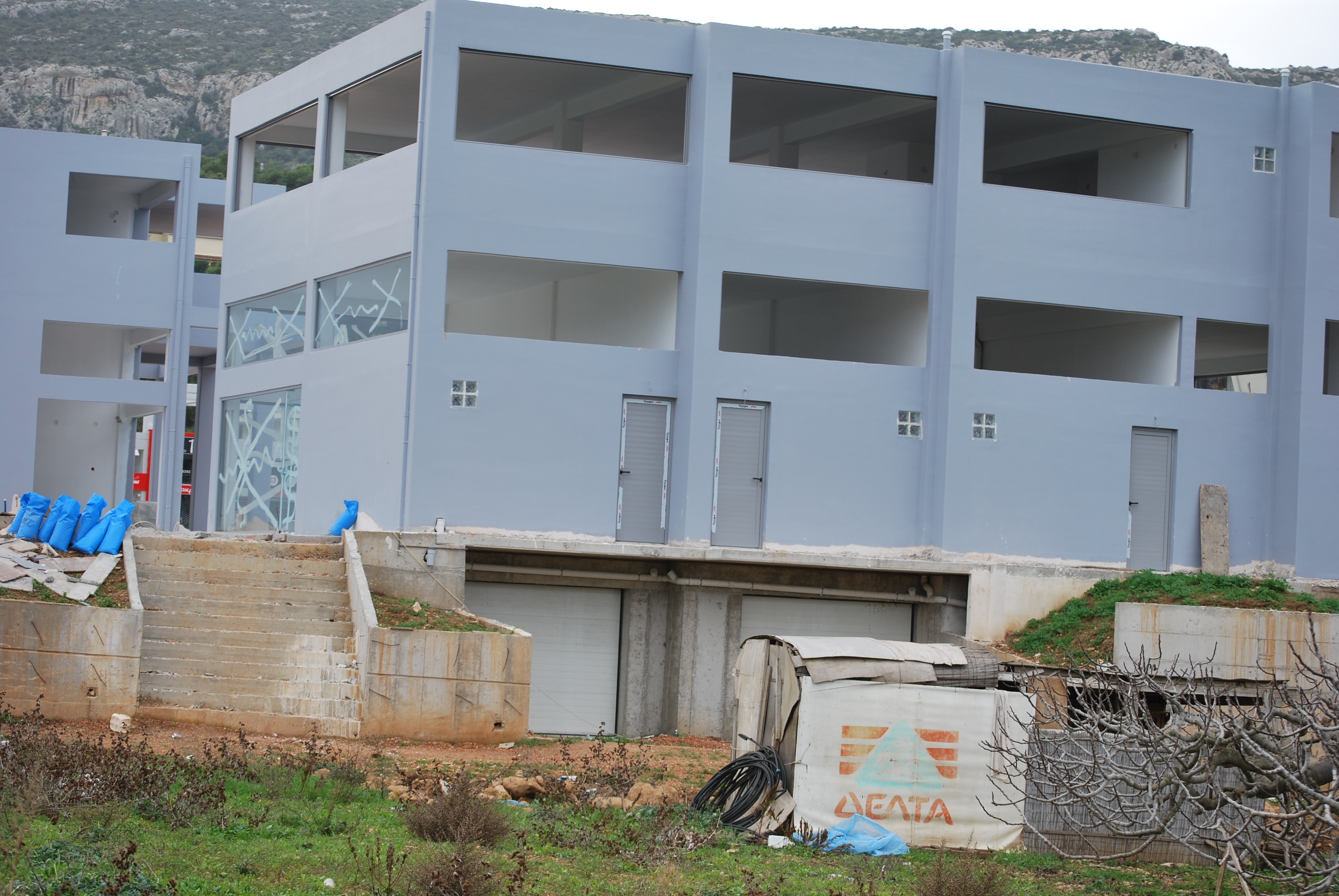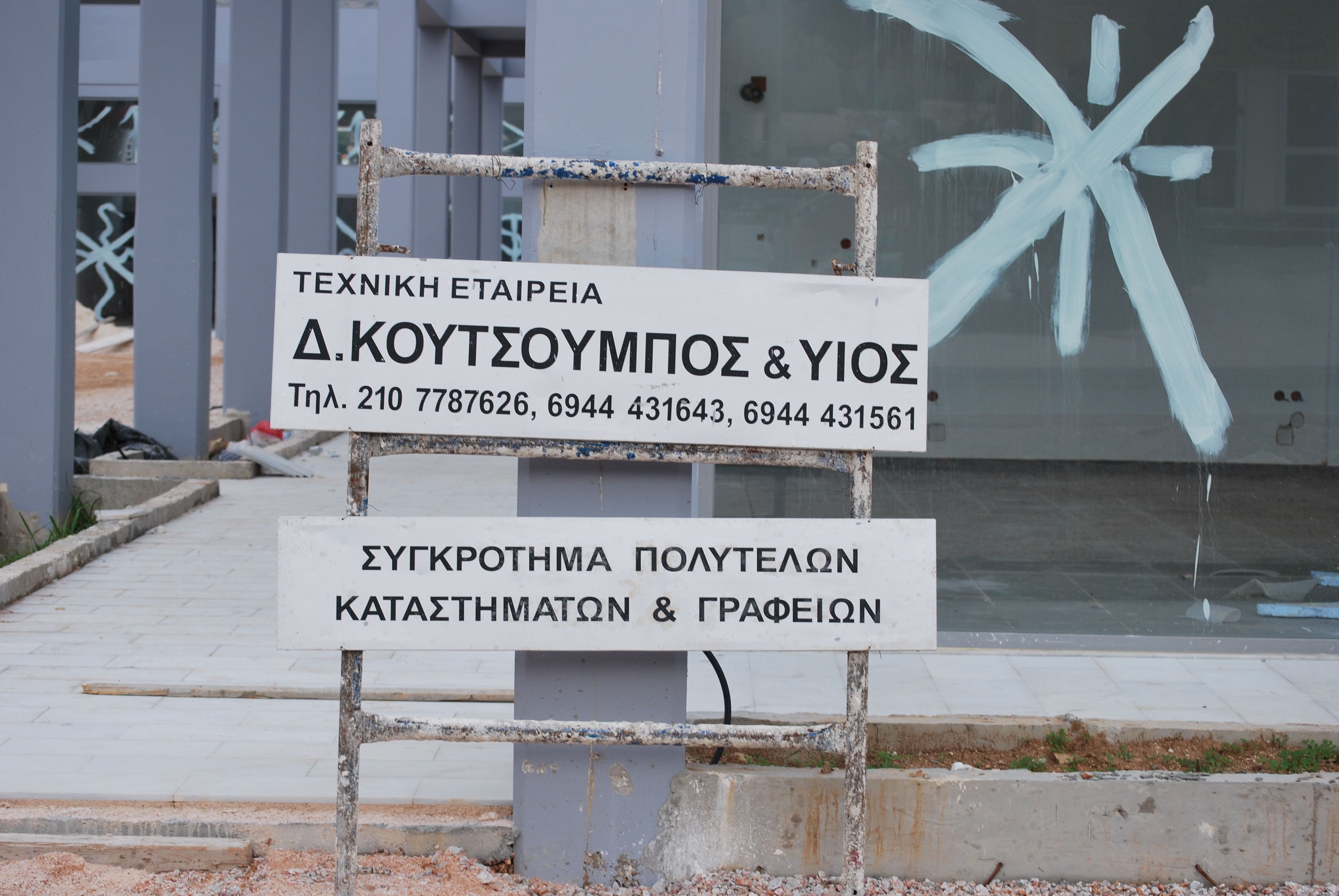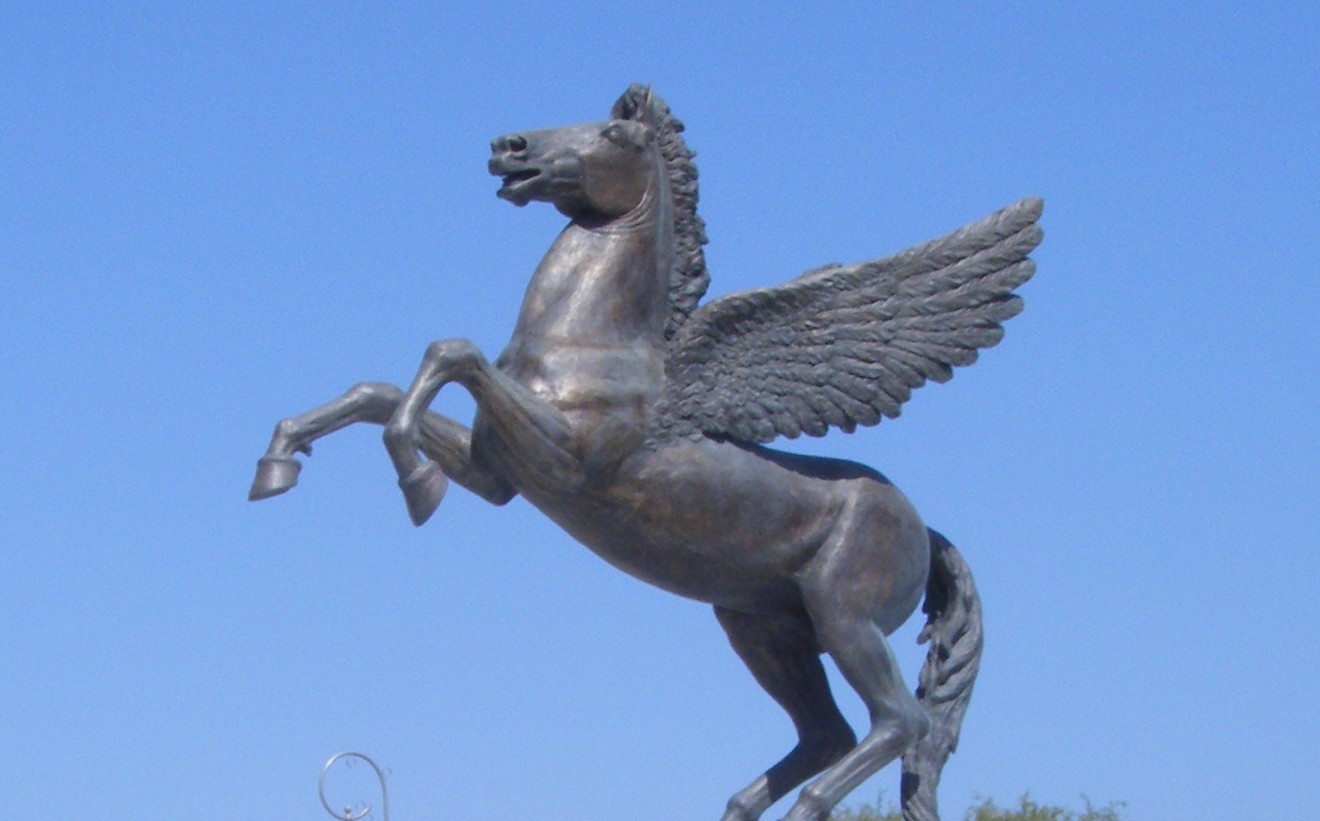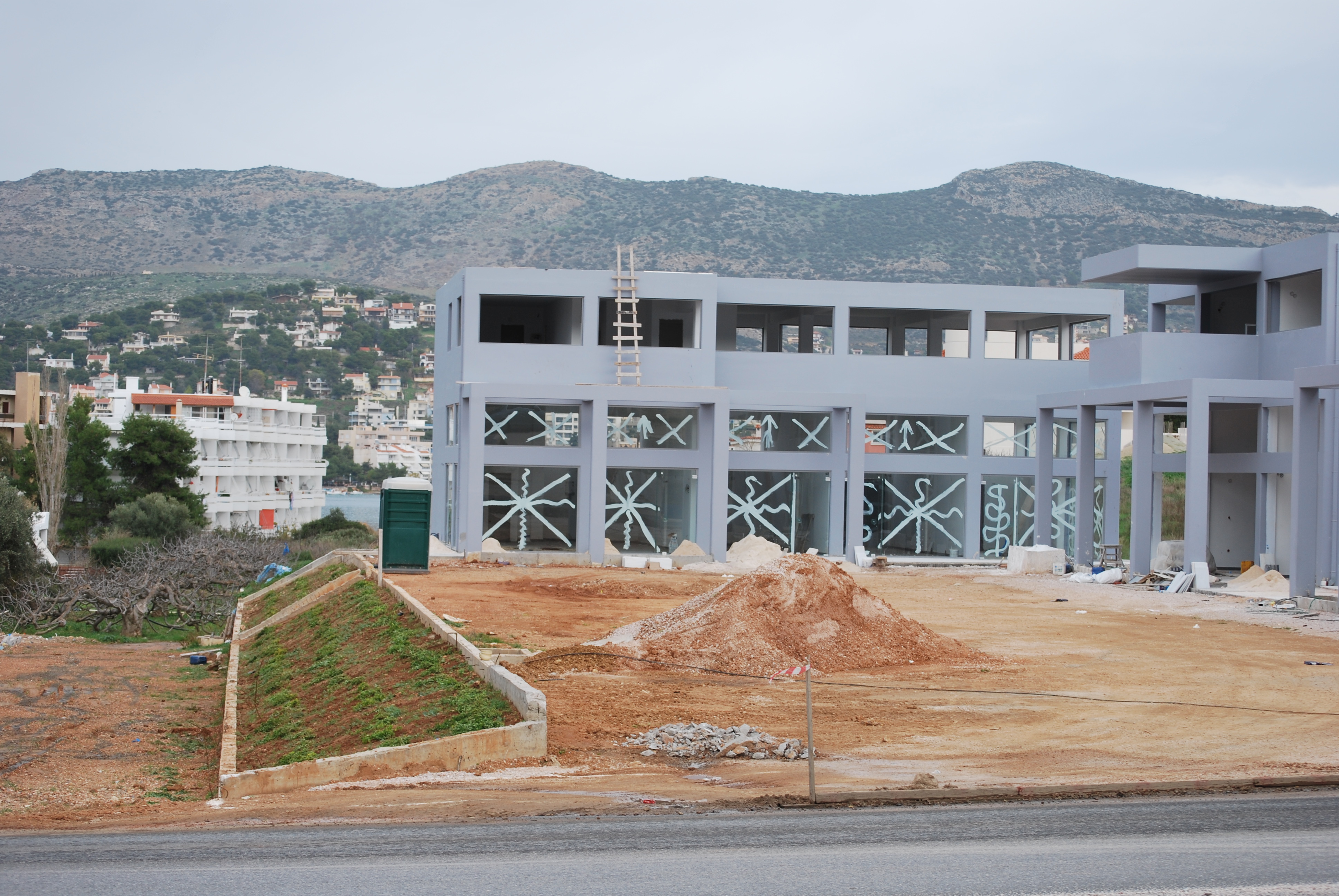Destroying Greek Heritage: The Temple of Aphrodite in Porto Rafti
How many countries do you know that dedicate themselves to destroying their own heritage? How many countries do you know that, at the same time, profit from their classical tradition? Greece must be one of them. The Greek government and the Greek people are proud for the development of two industries: shipping and tourism. Of these, tourism relies heavily on the existence, upkeep and advertisement of its ancient monuments. The ministry of tourism focuses its campaigns on the “fact” that Greece is the cradle of western civilization… and banks on it! It is a pity, though, that the anticipation of future profits does not guarantee the preservation of the majority of the archaeological sites.
 Take as an example the Temple of Aphrodite, depicted in the picture on the left. Oh I am sorry! Do you find it hard to distinguish the high columns, the elaborate marble decoration or the magnificent statues? You should not blame your archaeological skills for your inability to identify the monument. The building in the picture is the monstrosity erected on top of the Hellenistic Temple of Aphrodite in Porto Rafti. Porto Rafti is a well know (to the Greeks) summer resort in the Eastern coast of Attica. It claims the existence of a Mycenaean cemetery, the fort of Koroni (which was used during the Chremonidean War), a Late Antique Church and cemetery and, last but not least, the aforementioned Hellenistic Temple. Only traces of the above monuments exist. In the case of the temple, though, they made certain that no “ruins” would be visible, not even to the eye of a trained archaeologist.
Take as an example the Temple of Aphrodite, depicted in the picture on the left. Oh I am sorry! Do you find it hard to distinguish the high columns, the elaborate marble decoration or the magnificent statues? You should not blame your archaeological skills for your inability to identify the monument. The building in the picture is the monstrosity erected on top of the Hellenistic Temple of Aphrodite in Porto Rafti. Porto Rafti is a well know (to the Greeks) summer resort in the Eastern coast of Attica. It claims the existence of a Mycenaean cemetery, the fort of Koroni (which was used during the Chremonidean War), a Late Antique Church and cemetery and, last but not least, the aforementioned Hellenistic Temple. Only traces of the above monuments exist. In the case of the temple, though, they made certain that no “ruins” would be visible, not even to the eye of a trained archaeologist.
The destruction of the Temple of Aphrodite started only recently. Since I live in the area, I found out about the rescue excavation and visited it three years ago. I noticed the good quality Hellenistic pottery and the strong foundations of the temple. No archaeologist was around, and so I conversed with the two Albanian workers, who explained to me the significance of the project. They also told me that part of the temple was noticed only after the building company (whose name and details is seen on the right below) started the erection of the modern shopping centre.  At the time, I have not taken any photographs, as I know from personal experience that it takes the good part of a decade to uncover a building of that size. I was wrong! When I visited again last month the whole area has been covered under piles of dirt. I searched in vain for traces of ancient materials.
At the time, I have not taken any photographs, as I know from personal experience that it takes the good part of a decade to uncover a building of that size. I was wrong! When I visited again last month the whole area has been covered under piles of dirt. I searched in vain for traces of ancient materials.
And my questions are the following: How is it possible the excavation was completed so quickly? Why wasn’t the local community informed of the significance of the excavation? Why weren’t there provisions for the preservation of, at least, part of the building? Why did the technical company of Koutsoumbos and Son, responsible for the new shopping centre, opted for creating a car park on top of the temple, instead of laying out a glass pavement? Can anyone blame me for being angry at the erection of the mostrosity seen below? What do you think?



Is this the temple?
http://www.portoraftinews.gr/pages/artemis.html
I found the photograph by following a link from the English Wikipedia article on Porto Rafti.
If this is the one, or if the temple was anything like that, then the destruction is horrifying. But I fear that the judgement of the market is that a decent tourism industry can be sustained by preserving a few key monuments (the Parthenon, Delphi, and so on). Too few people will want to study all of the temples in order to draw historical or archaeological conclusions.
I do not agree with the judgement of the market on this one, but that is because I attach greater worth than many people would attach to the preservation of historical artefacts. But how can one stop market forces in their destructive tracks without infringing liberty? In England we have the system of listed buildings. Does Greece have anything similar? I hear that in Greece, building on newly-burnt woodland is to be banned, in order to deprive people of an incentive to start fires. So it is possible to legislate against the interests of property developers.
The temple in the photo you linked represents the Temple of Artemis Vravronia. It is very close to Porto Rafti but it is not the one I am refering to. The Temple of Aphrodite they uncovered has been revealed only recently and has not been excavated fully.
I understand that there are too many temples in Greece to be preserved. However, this is not a good reason to bury them under tons of dirt. They could still create a glass roof, on top of which potential shoppers could got to the shops AND look at the temple beneath their feet. After all the history of the place is not just for sale to tourists. It is also part of who we are. It forms our identity.
In Greece we have an excellent system for the preservation of buildings. And we also have a series of laws that forbid building on burned land. The problem is not with the laws but with their enforcement.
Also when ancient remain are uncovered, the local archaeological ephorate takes over the land and performs a rescue excavation. Once this is finished they either return the land to the owner or they buy the land in order to create an archaeological park. In the case of the Temple of Aphrodite, it is obvious that the first happened. In this case, though, two things bother me: a) the speed of the cover up and b) the total submersion of the site under the shopping mall, without considering the possibility of protecting some of it.
Constantina, you’ve asked: ‘Why did the technical company of Koutsoumbos and Son, responsible for the new shopping centre, opted for creating a car park on top of the temple, instead of laying out a glass pavement?’
I am not familiar with this particular case, but generally speaking, techical companies have very little to say in cases like this. The decision of whether/how the ruins would be preserved in situ is made by the Central Archaeological Council. The local Ephorate would make a recommendation and the Council would decide.
No local communities are consulted; no technical companies are asked their opinion; not even the Minister of Culture himself/herself can do anything about it. (Archaeological) Heritage, like national identity, is centrally produced in Greece – offers better ‘control’…
Greece has very strict legislation with regards to the preservation, looting, etc of antiquities; much stricter than in other countries and too strict, if you ask me.
There are generally four options, after a rescue excavation is completed:
1. Excavation and destruction of site – construction continues
2. Boxed and reburied – construction continues
3. Preservation in basement – construction continues above this
4. Preservation in open space – construction stops – the site becomes an archaeological site/park.
Option 3 was popular in the past – not any more, although continues to exist (the archaeological site in the basement of the new Acropolis Museum is such a case!). However, it is expensive and complicated.
Option 4 is rare; too expensive and creates lots of tensions with owners/residents. The site needs to be of exceptional archaeological significance for option 4 to happen.
Temples are usually preserved in some way – they are considered to be of more importance than say cemeteries, so I am a little surprised to hear (and see!) that construction went ahead with no provision for in situ preservation. Unless the technical company has acted illegally (it does happen), it may mean that there were too few architectural ruins to justify options 3 or 4.
Finally, since you’ve mentioned local communities: Local communities have traditionally been seen by the archaeological service in Greece as the ‘enemy’. It is a role-play that goes on decades now, whereby archaeologists are the ‘protectors’ and residents are the ‘destructors’. Public archaeology or community archaeology are inexistent in Greece.
On the other hand, it’s probably the case that the majority of the local residents of Porto Rafti, if asked, would go for the shopping centre, instead of the miserable, worn out, old little stones of the temple.
Symbolism of heritage is strong with the Greeks; its materiality not…
Sorry for the long comment.
Thank you for the long post. It has been very instructive. You certainly answer some of my questions. The temple, as far as I have seen, was not in an excellent condition. But it did not merit complete annihilation either. I am still surprised that the ephorate recommended that it is burried… again. As for the community in Porto Rafti, I would like to believe that they would be interested in the temple more than the shopping centre. It is a rather new community that is only now forging its identity.